Green Hydrogen Myths Debunked: Separating Fact from Fiction
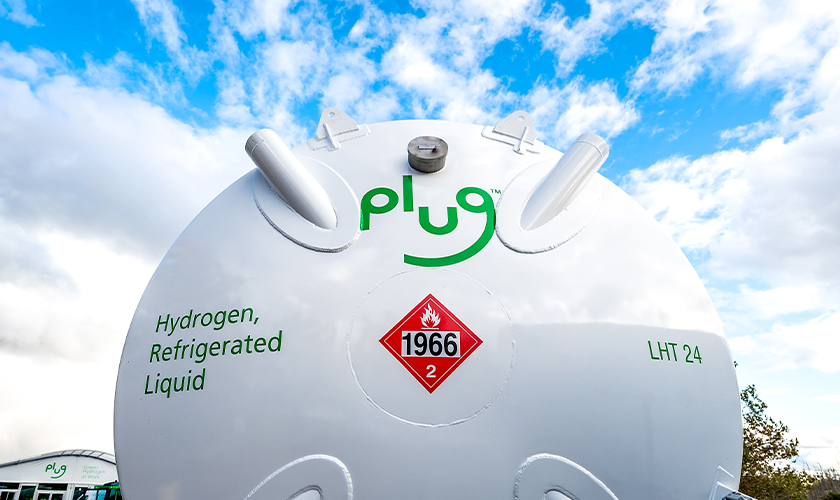
As an energy resource quickly emerging globally, green hydrogen has received attention for its ability to decarbonize tough greenhouse gas-intensive sectors such as ammonia production and reliable backup electricity power as the world shifts from fossil fuel dependency.
Many view green hydrogen, a fuel for which Plug serves as a global leading provider of turnkey solutions, as crucial for countries and companies to meet mid-century “net zero” greenhouse gas emissions targets. The energy consultancy Rhodium Group, among others, has referred to green hydrogen as the “swiss army knife of long-term decarbonization.”
Yet, though a consensus has grown that green hydrogen will play a key role in assisting governmental and private sector sustainability goals due to its wide-ranging applications, some common myths and misconceptions still persist. These include its purported high costs, lack of scalability, questionable green credentials, safety hazards, unproven technological readiness, heavy water usage, challenged versatility and reliability, and more.
One-by-one, this blog post will separate fact from fiction on green hydrogen for these claims and debunk common myths about this crucial fuel of the future.
Myth #1: Green Hydrogen is Not Cost-Effective
One major myth about green hydrogen made by its detractors is that it is unduly costly. Those costs, the argument goes, will inhibit rapid systemwide and global uptake of the energy resource.
That’s the narrative. And then there’s reality.
On the market, green hydrogen has already at times been cheaper than natural gas in Europe. In the U.S, too, green hydrogen got a major boost via the Inflation Reduction Act’s passage. The law offers $3/kg in tax incentives for producers of the fuel for projects built through 2032, known as the 45V credit. The law also has earmarked $30 billion in subsidies for the hydrogen sector.
Globally, researchers from the European Technology and Innovation Platform for Photovoltaics have concluded that by 2030, green hydrogen produced via solar energy will outcompete natural gas-based forms of hydrogen on a unit-by-unit costs basis. And BloombergNEF has analyzed that the same could happen across the board, not just limited to solar, by 2050.
Some have painted the picture of an even more rapid timeline.
For example, the consultancy ICF Climate Center has concluded that “green hydrogen could reach [cost] parity with more greenhouse-gas intensive ways of making the gas in as little as the next decade,” Axios reported, a projection on par with one made by researchers in a 2019 article published in the prestigious journal Nature Energy.
While some have made end of the decade predictions, others have hastened the timeline. Among them, the environmental advocacy group Rocky Mountain Institute predicted in a 2021 report that “Green hydrogen production costs could fall below $2 per kilogram in many locations in the next five years.” RMI further stated that “Similar to cost decline track records of solar PV, wind power, and other emerging energy solutions, it is expected that electrolyzer plant capital cost will drop significantly as installed capacity increases and over time.”
The think-tank Rethink Energy is even more bullish, gleaning that in 2022 that by 2024, green hydrogen could outcompete fossil fuel-based hydrogen on a price point basis.
Energy consultancy Wood Mackenzie has also concluded that by 2030 in many parts of the U.S., the price of hydrogen could drop to $1/kg and $2/kg in many others. Currently, the price is $5/kg. Globally, PricewaterhouseCoopers expects similar price drops to take place by 2050.
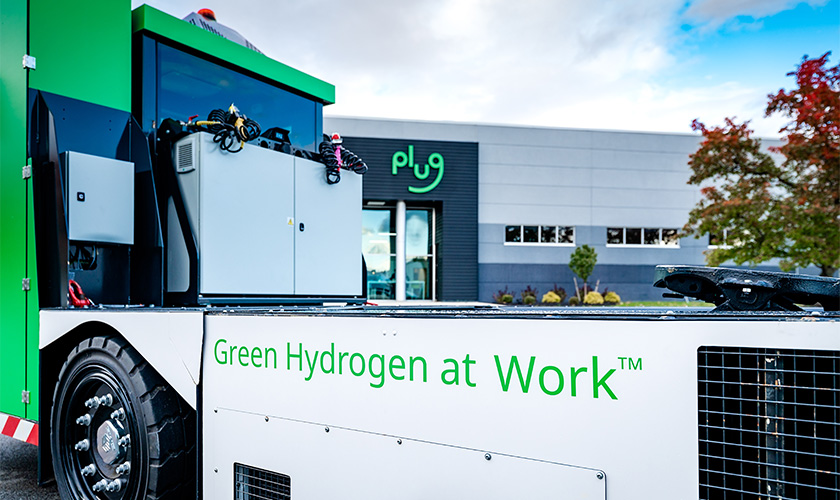
Myth #2: Green Hydrogen is Not Scalable
Many also point to issues with scaling green hydrogen, tied to the costs cited above, but also current lack of infrastructure and uptake among various sectors. Yet, experts have drawn diametrically different conclusions about green hydrogen’s near-term scalability and technological readiness.
In a 2022 report, Goldman Sachs predicted that by 2030, there would be between 65 and 180 GW of green hydrogen electrolyzer capacity, which “represents a remarkable 200-600 fold increase” compared to what existed on the report’s release date. And by 2050, in a jointly written report published by the Hydrogen Council and McKinsey & Company in November 2021 before the Inflation Reduction Act passed, the authors surmised that in 2050 between 60-80% of all global hydrogen production will be of the green variety.
Rhodium Group, citing green hydrogen-friendly policy in the U.S. context, has further pointed to the history of the rapid scaling of wind and solar as instructive.
“How fast can electrolyzers scale up?,” Rhodium asked in a March 2023 policy brief. “During their fastest 10-year periods of scale-up this century, utility-scale wind installations grew by an average of 42% per year, and utility-scale solar installations grew by an average of 97% per year.”
To that point, Goldman Sachs predicts that by 2050, that number will jump to 25% and that green hydrogen will be a sector worth $10 trillion.
And in its report “Hydrogen costs 2021: getting ready to scale,” Wood Mackenzie states that — owing to the price drop in electrolyzers, for which Plug serves as an industry leading producer and marketer — the Proton Exchange Membrane (PEM) electrolyzer technology Plug uses earned strong ratings for its ability to drive costs down further in the 2020’s. That’s due to attributes unique to PEM technology such as modularity, manufacturing automation, and materials costs. Overall, PwC gave PEM fuel cells the strongest ratings for their array of cost reduction drivers.
Myth #3: Green Hydrogen Production is Unsustainable
When dependent on fossil fuels, the science shows skepticism is warranted on hydrogen. But that is not the case for green hydrogen, which utilizes carbon-free non-fossil fuel energy sources such as wind, solar, and bioenergy in manufacturing the fuel.
Columbia University’s Climate School points out that for hard to abate sectors, transitioning to green hydrogen will be crucial for meeting global climate goals set under the 2015 Paris Agreement.
“Energy efficiency, renewable power, and direct electrification can reduce emissions from electricity production and a portion of transportation; but the last 15 percent or so of the economy, comprising aviation, shipping, long-distance trucking and concrete and steel manufacturing, is difficult to decarbonize because these sectors require high energy density fuel or intense heat,” Columbia details. “Green hydrogen could meet these needs.”
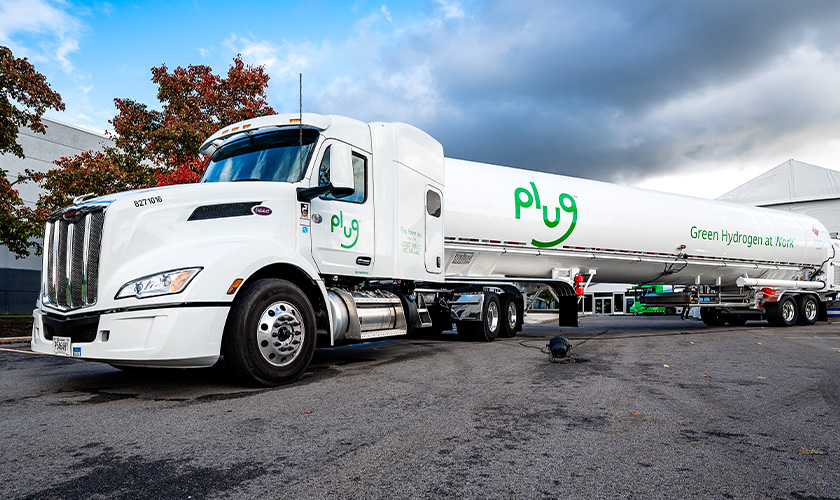
Myth #4: Green Hydrogen is Unsafe
Due to movies and other false depictions, hydrogen has sometimes received a depiction as an unsafe fuel. Its stellar safety track record says otherwise, though.
While combustible like nearly every other liquid-based energy resource, hydrogen’s flammability is not up for question. Compared to natural gas and oil, though, hydrogen dissipates far more quickly. And because it’s not a hydrocarbon flame laced with a wide range of carcinogenic chemical compounds, the risk of a secondary fire is far lower than for petrochemicals and natural gas liquids.
While hydrogen is a much smaller molecule than the methane in natural gas, as a case in point, studies conclude it leaks from pipes at roughly the same rate. Given it’s 14 times lighter than air, it escapes into the air and floats away, while natural gas pools near the leak and creates an explosion hazard. And not only an explosion hazard: natural gas leaks also create a major public health risk including exposure to chemical toxin compounds, a risk that does not exist with hydrogen due to its non-toxicity and propensity to float away.
Compared to gasoline, natural gas, uranium, jet fuel, and diesel, the U.S. Department of Energy’s Hydrogen and Fuel Cells Technologies Office has written that “a number of hydrogen’s properties make it safer to handle and use than the fuels commonly used today.”
Environmental advocacy group Natural Resources Defense Council has also lauded green hydrogen’s safety accolades.
“To evaluate hydrogen’s safety, it must be compared to that of other conventional fuels like gasoline, propane, and diesel,” NRDC has stated. “While no fuel is 100 percent safe, green hydrogen has been shown to be safer than conventional fuels in a multitude of aspects.”
Plug additionally takes safety seriously, having maintained a sterling track record and active membership in the Center for Hydrogen Safety for the past quarter century to keep up with and advance industrial best practices.
Myth #5: Green Hydrogen Technology is Immature
Pointing to what is today a tiny niche green hydrogen global market, some skeptics of the energy resource say this indicates lack of technological readiness and maturity.
In reality, the technology is here and it is a matter of creating incentives and deploying it. The Rocky Mountain Institute has compared the technology’s state of play to an “S Curve.”
What’s an S Curve, you ask? RMI details that it means technological growth that starts “slow at first, then rapidly [rises], before flattening out again as it reaches market saturation.”
“We are now observing increased policy action, corporate commitments, and investments on both supply and demand sides in green hydrogen markets,” RMI further stated why it believes green hydrogen has achieved S-Curve status. “The decreasing costs of renewables are rapidly reducing the cost of green hydrogen. These are all signals of the third phase, when an innovation advances from pilot projects to the creation of new markets by linking early supply and demand.”
A sign of the technology’s maturity and marketwide appetite therein, Plug manufactured a company and industry record high 122 megawatts of green hydrogen electrolyzers in the first quarter of 2023 alone.
Myth #6: Green Hydrogen is Inefficient
Hydrogen fuel cells are generally between 40% to 60% energy efficient, U.S. Department of Energy data shows. This compares favorably to a car’s internal combustion engine, running at about 25% energy efficiency.
It is true, however, that Plug’s hydrogen fuel cells are less efficient than battery technology. Crucially though, efficiency is not the only metric that matters when examining enterprise-scale use of a technology.
Fuel cells boost productivity favorably compared to batteries due to their ability to operate in wider temperature ranges and utilize shorter refueling time needs. Further, they have roughly 25% greater range when used within automobiles. These attributes, when applied to Plug’s industry-leading deployment of fuel cell forklifts, boost warehouse productivity (and yes, overall efficiency) by up to 15%.
Myth #7: Green Hydrogen Production Requires Too Much Water
Though some have erroneously argued that green hydrogen is water guzzling, it is actually a far less water-intense energy production mode than its fossil fuel counterparts. It has won praise, for example, from climate advocates such as the Environmental Working Group.
“The clean energy solution that could succeed in curbing carbon emissions, saving ratepayers money on their power bills and reducing adverse impacts on water supplies, is green hydrogen,” writes EWG. “It is the best way to produce hydrogen, separating hydrogen from oxygen in water using wind, solar or hydro.”
“The freshwater consumption from this volume of hydrogen production would be less than one percent of current total global freshwater consumption,” EWG detailed in pointing to the data.
In a 2021 study published in the journal Fuel Cells Bulletin, the authors agreed with EWG’s water assessment, while also noting that “Benefits will also accrue for the water sector, including improving the efficiency of wastewater treatment, oxygenating…water bodies, improving the provision of drinking water supplies in arid regions, and making better use of the seawater resource.”
Plug, when compared to power producers of other energy resources, also utilizes less water than most other energy sources.
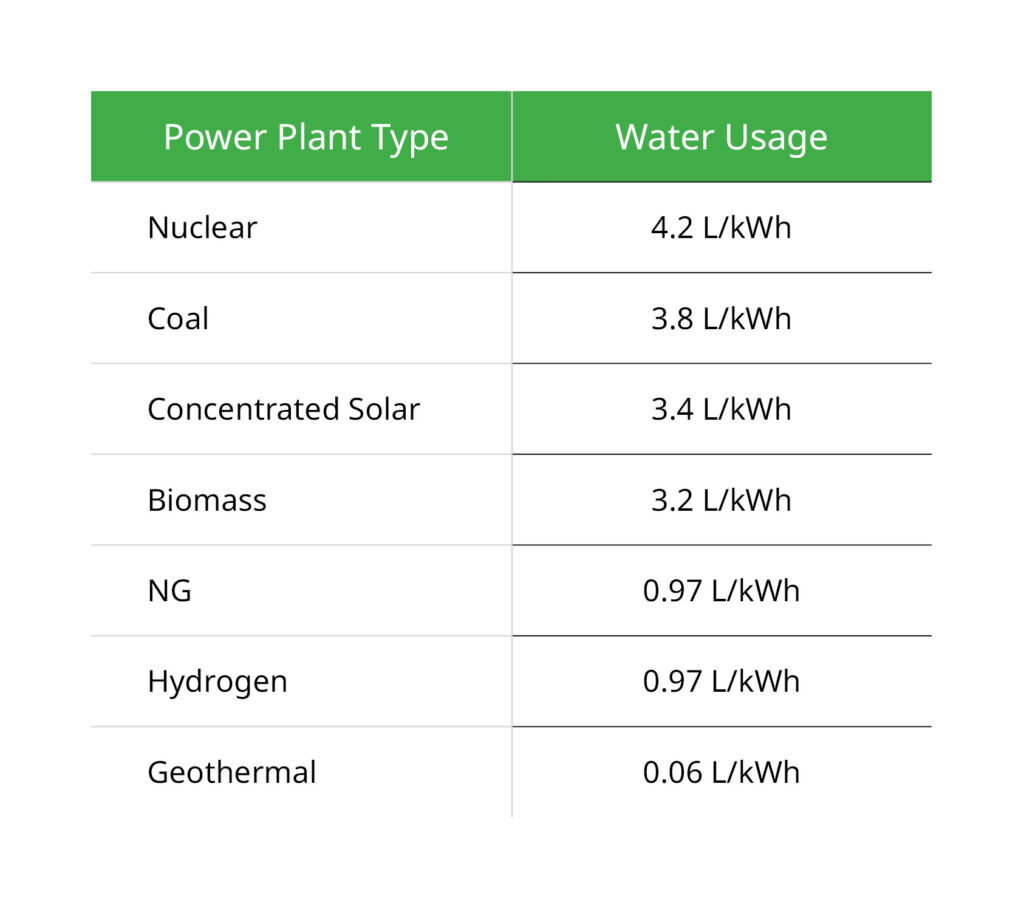
Myth #8: Green Hydrogen is not versatile enough
Compared to other renewable energy resources, green hydrogen is among the most versatile of the genre. Unlike other renewable energy sources, too, green hydrogen does not suffer from intermittency like solar and wind energy.
Green hydrogen has earned the “Swiss army knife” moniker, with across-the-board functionality. Green hydrogen applications include primary or backup power, mobility ranging from forklifts to heavy haul vehicles, fueling infrastructure, robotics such as drones, microgrids, green methanol production, and far more.
Myth #9: Green Hydrogen is Unreliable
Hydrogen, counter to some claims, is a highly reliable fuel. In fact, its reliability surpasses that of batteries in very hot or cold weather conditions, while Plug’s PEM fuel cells are engineered to ensure maximum robustness — an operational “sweet spot” ensuring durability and reliability over longer time periods.
At Plug’s 2022 Symposium, the frozen foods warehousing and logistics company, FreezPak noted that it has saved 31.5% in electricity since beginning its partnership with Plug in 2014 due to this reliability.
The reliability of Plug’s hydrogen fuel cells also saves time, which equals money. Swapping batteries can take up to 15 to 20 minutes per battery. By contrast, refueling hydrogen fuel cells takes less than three minutes.
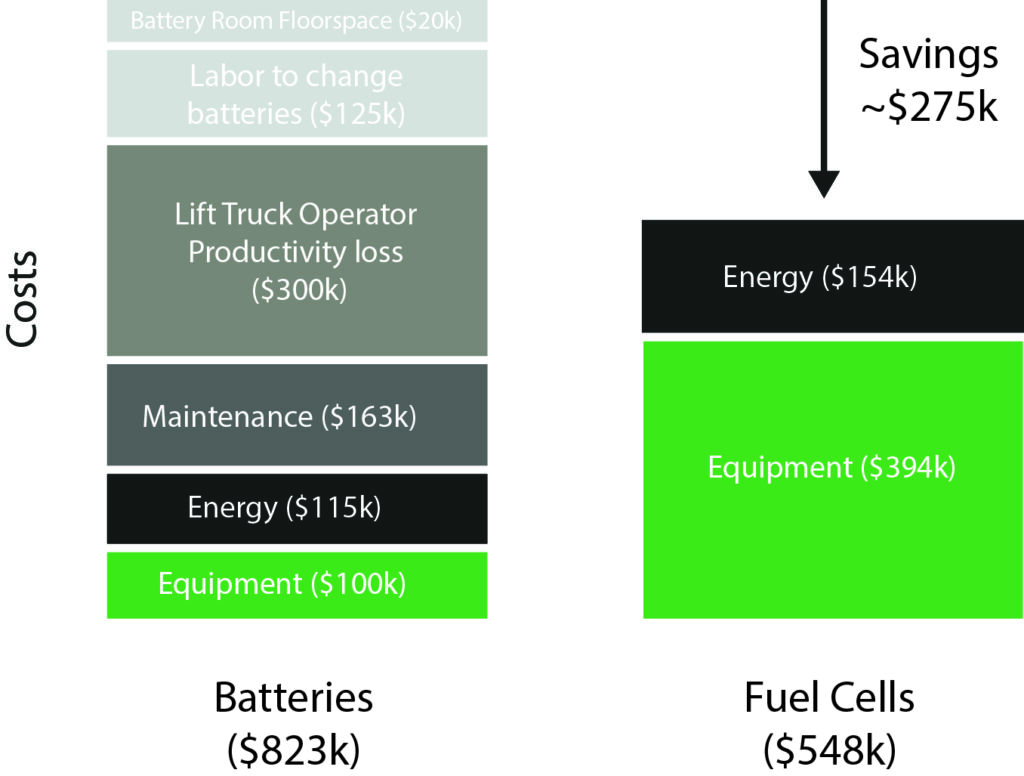
Myth #10: Green Hydrogen is Incompatible with Existing Infrastructure
Another big overarching myth about hydrogen is that it is not compatible with current infrastructure. It is true, in large part, that more infrastructure buildout is needed to market green hydrogen, something Plug hasn’t shied away from stating.
In July 2022 congressional testimony, Plug COE Andy Marsh called for “a vastly more expansive [hydrogen pipeline] system…akin to that of the more than 2 million miles of natural gas pipeline in the United States” as a means of scaling the U.S. green hydrogen industry. By juxtaposition, 1,600 miles of hydrogen pipelines crisscross the U.S. today.
Yet, as Plug and its peers await more pipeline capacity, scientists have concluded that even current natural gas pipeline capacity can be utilized to move the product when blended with natural gas. Further, hydrogen can also currently be moved in trucks— including those designed by Plug — and potentially rail, as well.
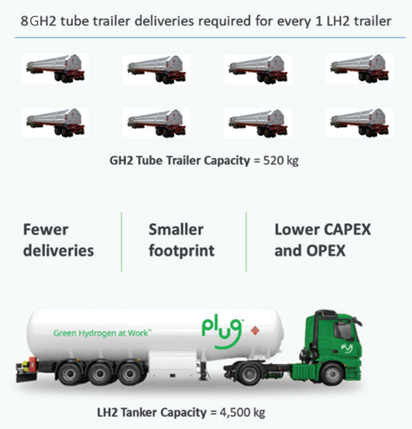
As it awaits a more robust green hydrogen infrastructure boom, Plug has not stood on the sidelines. Instead, Plug has taken a global lead in realizing myriad green hydrogen use cases to lay the groundwork for a much-needed hydrogen logistics infrastructure boom.
Correcting the Record on Green Hydrogen
Green hydrogen cannot only help the world achieve its mid-century goals, as highlighted here, but also more accelerated decadal ones. Not merely a fuel far off into the horizon, green hydrogen can reliably and safely power myriad facets of society today.
Its capacity to do so has grown as governments create climate policy plans propelling the fuel from the periphery to the epicenter. It can also help the world stave off water scarcity issues, one of the key issues facing humanity alongside climate change.
Yet, some have called green hydrogen’s well-documented efficacy into question, creating narratives that could be harmful to developing a fuel source crucial for fast-tracking the much-needed energy transition as climate change impacts lock in. This article stands as a long-term corrective to combat these misconceptions.
Thank you for reading this article and please see our “Hydrogen 101” blog post, which offers an A to Z list to drill down on more of the topics covered here. And to learn more about our hydrogen and fuel cell products, please contact us! We’d love to hear from you.
The post Green Hydrogen Myths Debunked: Separating Fact from Fiction appeared first on Plug Power.